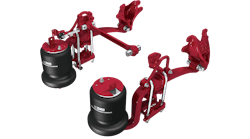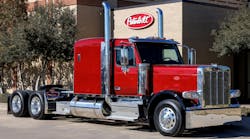A Good highway system takes money, and the federal fuel tax remains the most cost-effective way to fund essential highway infrastructure projects.
That was the message Barbara Windsor delivered in late July on behalf of the American Trucking Associations (ATA) to the Subcommittee on Select Revenue Measures, which is part of the House of Representatives' Ways and Means Committee. Windsor is ATA second vice-chairman and president and chief executive officer of Hahn Transportation.
“With collection costs at just 0.2% of revenue, the federal fuel tax is unmatched in efficiency and equitability by any alternative funding scheme,” she said. “The federal fuel tax is by far the best way to ensure sufficient funding for highway projects over the near term.”
Windsor went on to say that more highway funding is needed for the future. Various assessments have estimated that all levels of government must invest between $134 billion and $194 billion annually just to maintain the highway system at its current condition and level of congestion. It would take $189 billion to $262 billion to improve highway infrastructure and meet congestion reduction levels.
At the federal level, the Highway Trust Fund (HTF) currently generates just enough revenue to support a $32 billion annual highway program. In coming years, it will take $60 billion to $87 billion to maintain the federal highway system, and $85 billion to $118 billion will be needed to make significant improvements.
A large share of the funding for highway infrastructure maintenance and improvement comes from the trucking industry. “In 2006, commercial trucks paid a third of state and federal highway users fees totaling $37.4 billion,” Windsor said. “This included $17.8 billion that was paid into the federal Highway Trust Fund, accounting for 45% of HTF receipts. In contrast, commercial trucks accounted for just 14.4% of total vehicle miles traveled in 2006.”
Other taxes paid into the federal HTF by commercial truck operators include:
-
Heavy Vehicle Use Tax (HVUT): trucks with registered weight of 55,000 to 75,000 pounds pay a HVUT of $100 plus $22 for each 1,000 pounds in excess of 55,000 pounds to a maximum tax of $550,000. This tax provided $1.4 billion to the HTF.
-
Sales Tax: Companies pay 12% the retailer's sales price for tractors and trucks over 33,000 pounds registered gross vehicle weight (GVW) and for trailers over 26,000 pounds GVW. This tax generated $3.6 billion for the HTF.
-
Tire Tax: Truck operators pay a tax on tires sold by manufacturers, producers, or importers at the rate of $.0945 ($04725 in the case of bias-ply or super single tire) for each 10 pounds of the maximum rated load capacity of 3,500 pounds. This tax produced $488 million for the HTF.
Windsor said that ATA believes the current tax system has worked well and should remain the primary funding source for HTF. At the same time, ATA recognizes that additional revenue sources may be needed in the future. New funding sources should meet the following criteria:
-
Minimize opportunities for evasion;
-
Inexpensive and simple for government to administer, collect, and enforce without imposing excessive administrative and record-keeping burdens on highway users;
-
Based currently on a readily verifiable measure of highway and vehicle use;
-
Reasonably uniform in application among classes of highway users; and
-
Won't create impediments to interstate commerce.
ATA continues to oppose turning existing sections of the interstate highway system into toll roads. ATA called it double taxation, and says charging tolls on top of highway use fees is inequitable, unfair, and inefficient. The association adds that tolls can be easily avoided by taking alternate, less safe routes.
Mileage taxes are being considered as a way to offset decreased gasoline and diesel sales as vehicles become more fuel efficient or shift to alternative energy sources. The mileage tax is less efficient than the current fuel tax. Compliance with this tax would require significant effort and expense.
ATA also is concerned about the interstate commerce implications of a mileage tax. Pricing could vary widely by geographic location. States could charge disproportionately higher fees based on geography. Federal oversight — and even control — would be needed to manage the system fairly.
Congestion pricing — another tolling scheme — is being considered in many areas. Under this arrangement, tolls increase during peak highway use times. Trucking already has found it difficult to assign tolls to individual deliveries, which means shippers have no incentive to change delivery schedules.








